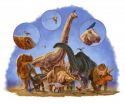Sprites form at plasma irregularities in the lower ionosphere
2014-05-07
(Press-News.org) Atmospheric sprites have been known for nearly a century, but their origins were a mystery. Now, a team of researchers has evidence that sprites form at plasma irregularities and may be useful in remote sensing of the lower ionosphere.
"We are trying to understand the origins of this phenomenon," said Victor Pasko, professor of electrical engineering, Penn State. "We would like to know how sprites are initiated and how they develop."
Sprites are an optical phenomenon that occur above thunderstorms in the D region of the ionosphere, the area of the atmosphere just above the dense lower atmosphere, about 37 to 56 miles above the Earth. The ionosphere is important because it facilitates the long distance radio communication and any disturbances in the ionosphere can affect radio transmission.
"In high-speed videos we can see the dynamics of sprite formation and then use that information to model and to reproduce the dynamics," said Jianqi Qin, postdoctoral fellow in electrical engineering, Penn State, who developed a model to study sprites.
Sprites occur above thunderstorms, but thunderstorms, while necessary for the appearance of a sprite, are not sufficient to initiate sprites. All thunderstorms and lightning strikes do not produce sprites. Recent modeling studies show that plasma irregularities in the ionosphere are a necessary condition for the initiation of sprite streamers, but no solid proof of those irregularities existed.
The researchers studied video observations of sprites, developed a model of how sprites evolve and disappear, and tested the model to see if they could recreate sprite-forming conditions. They report their results today (May 7) in Nature Communications.
Sprites resemble reddish orange jellyfish with bluish filamentary tendrils hanging down below. Careful examination of videos of sprites forming showed that their downward hanging filaments form much more rapidly than in the horizontal spread, leading the researchers to suggest that localized plasma irregularities cause the streamers to propagate.
The researchers used a two-dimensional cylindrical symmetric plasma fluid model, a mathematical model of the ionization movements in the sprite, to study sprite dynamics. They then used the model to recreate optical sprite creation. From this recreation, the researchers determined where the sprite streamers originated, and they could estimate the size of the plasma irregularity.
Further analysis suggested some potential causes of these plasma irregularities. The most obvious seems to be the existence in that area of a previous sprite. For the sprites examined, there were no previous sprites in that area that occurred close enough in time, unless there were long-lasting irregularities. However, the researchers are unsure how such long-lasting events could occur.
Another possible source for the irregularities is meteor events. The D region of the ionosphere is in the upper part of the atmosphere where most meteors can exist, because once they enter the denser, lower atmosphere, they burn up due to atmospheric friction.
"This technique can be used for remote sensing in the ionosphere as well," said Pasko. "Using high speed videos and fluid models we may be able to see other things that go on in the ionosphere and better understand the effects of various natural phenomena on very low frequency radio communications."
INFORMATION:
Also working on this project were Matthew G. McHarg, professor of physics and director, United States Air Force Academy Space Physics and Atmospheric Research Center, and Hans C. Stenbaek-Nielsen, professor of geophysics emeritus, University of Alaska, Fairbanks.
The National Science Foundation and the Defense Advanced Research Projects Agency supported this work.
ELSE PRESS RELEASES FROM THIS DATE:
International molecular screening program for metastatic breast cancer AURORA at IMPAKT
2014-05-07
While research has made great strides in recent decades to improve and significantly extend the lives of patients with early breast cancer, the needs of patients with advanced or metastatic disease have largely been ignored. Moreover, despite the fact that the overall breast cancer death rate has dropped steadily over the last decade and significant improvements in survival have been made, metastatic breast cancer represents the leading cause of death among patients with the disease.
In this context the Breast International Group (BIG) recently launched AURORA, which ...
Nearest bright 'hypervelocity star' found
2014-05-07
SALT LAKE CITY, May 7, 2014 – A University of Utah-led team discovered a "hypervelocity star" that is the closest, second-brightest and among the largest of 20 found so far. Speeding at more than 1 million mph, the star may provide clues about the supermassive black hole at the center of our Milky Way and the halo of mysterious "dark matter" surrounding the galaxy, astronomers say.
"The hypervelocity star tells us a lot about our galaxy – especially its center and the dark matter halo," says Zheng Zheng, an assistant professor of physics and astronomy and lead author ...
All teeth and claws? New study sheds light on dinosaur claw function
2014-05-07
Theropod dinosaurs, a group which includes such famous species as Tyrannosaurus rex and Velociraptor, are often regarded as carnivorous and predatory animals, using their sharp teeth and claws to capture and dispatch prey. However, a detailed look at the claws on their forelimbs revealed that the form and shape of theropod claws are highly variable and might also have been used for other tasks.
Inspired by this broad spectrum of claw morphologies, Dr Stephan Lautenschlager from Bristol's School of Earth Sciences studied the differences in claw shape and how these are ...
Revealing the healing of Dino-sores
2014-05-07
Scientists have used state-of-the-art imaging techniques to examine the cracks, fractures and breaks in the bones of a 150 million-year-old predatory dinosaur.
The University of Manchester researchers say their groundbreaking work – using synchrotron-imaging techniques – sheds new light, literally, on the healing process that took place when these magnificent animals were still alive.
The research, published in the Royal Society journal Interface, took advantage of the fact that dinosaur bones occasionally preserve evidence of trauma, sickness and the subsequent signs ...
Study finds pregnant women show increased activity in right side of brain
2014-05-07
Pregnant women show increased activity in the area of the brain related to emotional skills as they prepare to bond with their babies, according to a new study by scientists at Royal Holloway, University of London.
The research, which will be presented at the British Psychological Society's annual conference on Wednesday 7 May, found that pregnant women use the right side of their brain more than new mothers do when they look at faces with emotive expressions.
"Our findings give us a significant insight into the 'baby brain' phenomenon that makes a woman more sensitive ...
Mass vaccination campaigns reduce the substantial burden of yellow fever in Africa
2014-05-07
Yellow fever, an acute viral disease, is estimated to have been responsible for 78,000 deaths in Africa in 2013 according to new research published in PLOS Medicine this week. The research by Neil Ferguson from Imperial College London, UK and colleagues from Imperial College, WHO and other institutions also estimates that recent mass vaccination campaigns against yellow fever have led to a 27% decrease in the burden of yellow fever across Africa in 2013.
Yellow fever is a serious viral disease that affects people living in and visiting tropical regions of Africa and ...
Water from improved sources is not consistently safe
2014-05-07
Although water from improved sources (such as piped water and bore holes) is less likely to contain fecal contamination than water from unimproved sources, improved sources in low- and middle-income countries are not consistently safe, according to a study by US and UK researchers, published in this week's PLOS Medicine.
These findings are important as WHO and UNICEF track progress towards the Millennium Development Goals water target using the indicator "use of an improved source": this study shows that assuming that "improved" water sources are safe greatly overestimates ...
Dinosaurs and birds kept evolving by shrinking
2014-05-07
Although most dinosaurs went extinct 65 million years ago, one dinosaur lineage survived and lives on today as a major evolutionary success story – the birds. But to what does this lineage owe its success? A study that has 'weighed' hundreds of dinosaurs now suggests that shrinking their bodies may have helped this group to continue exploiting new ecological niches throughout their evolution, and to become such a diverse and widespread group of animals today.
An international team, led by scientists from Oxford University and the Royal Ontario Museum, estimated the body ...
Shrinking helped dinosaurs and birds to keep evolving
2014-05-07
A study that has 'weighed' hundreds of dinosaurs suggests that shrinking their bodies may have helped the group that became birds to continue exploiting new ecological niches throughout their evolution, and become hugely successful today.
An international team, led by scientists at Oxford University and the Royal Ontario Museum, estimated the body mass of 426 dinosaur species based on the thickness of their leg bones. The team found that dinosaurs showed rapid rates of body size evolution shortly after their origins, around 220 million years ago. However, these soon slowed: ...
Patients with AMD may not need monthly injections
2014-05-07
Orlando, Fla. — Researchers have found that, contrary to prvious clinical trial findings, monthly injections to counteract age-related macular degeneration (AMD) may not be necessary. The research is being presented at the 2014 Annual Meeting of the Association for Research in Vision and Ophthalmology (ARVO) this week in Orlando, Fla.
The investigators used a strategy called "treat and extend" to conduct the study, in which the frequency of office visits and injections were tailored to each patient's individual response to therapy. Following 185 patients over a three-and-a-half-year ...


